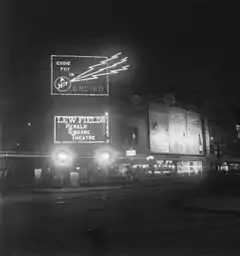Herald Square Theatre
The Herald Square Theatre was a Broadway theatre in Manhattan, New York City, built in 1883 and closed in 1914. The site is now a highrise designed by H. Craig Severance.[1]
 Herald Square Theatre in 1907 | |

| |
| Former names | (New) Park Theatre (1883–1894) |
|---|---|
| Address | 1331 Broadway New York City United States |
| Type | Broadway |
| Capacity | 1150 |
| Construction | |
| Closed | 1914 |
| Demolished | 1915 |
| Years active | 1883 - 1914 |
| Architect | Rose & Stone |
History
The Park Theatre opened in 1883 (also known as the New Park Theatre) on the partly demolished site of the Great New York Aquarium (1876–1881),[1] which is unrelated to the later New York Aquarium. Actor Charles E. Evans, retiring from the stage with cash in hand from the long-running success of A Parlor Match, refurbished the prior Harrigan's Park Theatre as the Herald Square Theatre in 1894.[2] It stood at 1331 Broadway, designed by architects Rose & Stone, with about 1150 seats and with its interior furnished by the interior of the nearby Booth's Theatre, which was being demolished. Lee Shubert took over the lease of the theatre in 1900, making it the first Broadway theatre owned by The Shubert Organization.
Partially destroyed by fire and rebuilt, in 1911 it became "the first New York theatre to be converted into a silent movie house", but it was demolished only three years later, as the Garment District expanded, and the Broadway theater district migrated north of 40th Street.[3][4]
The theatre offered a variety of entertainment, from plays, like Shaw's Arms and the Man (1894), to Edwardian musical comedies, like The Girl from Kay's (1903–1904) and The Girl Behind the Counter (1907–1908), to operetta, like Reginald De Koven and Harry B. Smith's Rob Roy.[5] It saw the first performance of the George M. Cohan song "You're a Grand Old Flag" in 1906, and it was also where William Randolph Hearst first saw and met his wife Millicent Willson during her appearance as a "bicycle girl" in 1897.
Selected performances
- Arms and the Man (September 1894) (with Richard Mansfield)
- Napoleon Bonaparte (October 1894)
- Rob Roy (October 1894 - March 1895)
- Pudd'nhead Wilson (April 1895) (dramatized by Frank M. Mayo)
- The Heart of Maryland (October 1895 - March 1896) (by David Belasco)
- A Parlor Match (revival) (September 1896)
- The Girl From Paris (December 1896 - July 1897; August 1897)
- Arizona (September 1900 - January 1901)[6]
- Dolly Varden (January 1902 - June 1902) (with Lulu Glaser)
- The Girl from Kays (November 1903 – May 1904; August–September 1904)
- The Rollicking Girl (May 1905 - October 1905)
- George Washington, Jr. (February 1906 - April 1906)
- Widower's Houses (March 1907)[7]
- The Orchid (April 1907 - September 1907)
- The Girl Behind the Counter (October 1907 - June 1908)
- Three Twins (June 1908 - December 1908, closed due to fire)
- The Beauty Spot (April 1909 - August 1909)
- Tillie's Nightmare (May 1910 - July 1910)
References
- Miller, Tom (2016-12-19). "The Lost Great New York Aquarium - Herald Square". Daytonian in Manhattan. Retrieved 2018-03-16.
- Who's who on the stage, p. 90 (1906)
- Herald Square Theatre at the Internet Broadway Database
- (10 July 1914). The Real Estate Field, The New York Times ("The property, on which is the Herald Square Theatre, has a Broadway frontage of 211.5 feet, 207 feet on Thirty-fifth Street and eight-one feet on Thirty-sixth Street.")
- Traubner, Richard (2003). Operetta: A Theatrical History, rev. ed. New York: Routledge. p. 342.
- Brown, Thomas Allston. A History of the New York Stage, Vol. III (1903)
- "Internet Broadway Database". Retrieved 2 January 2020.